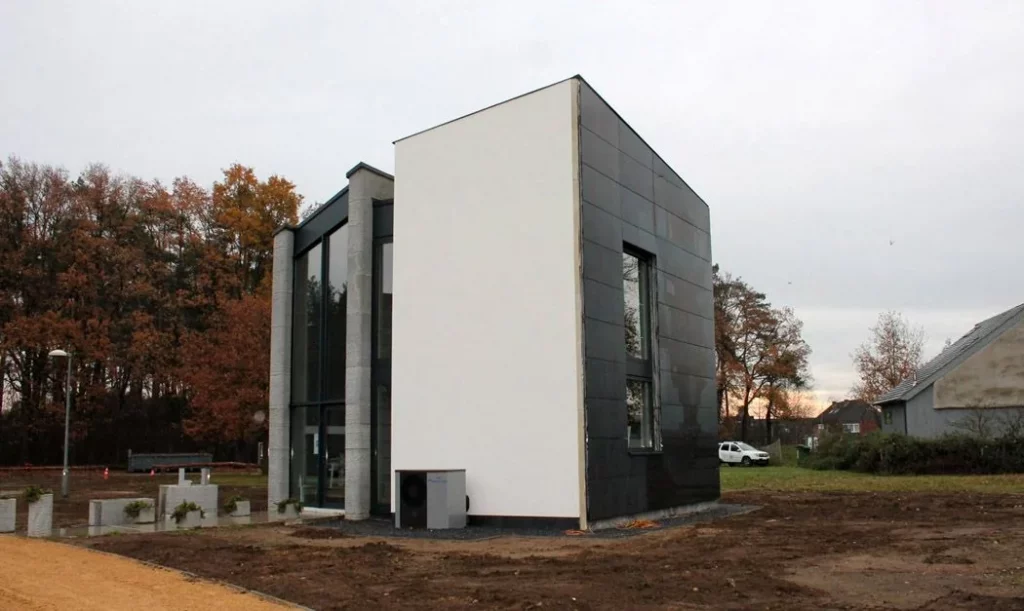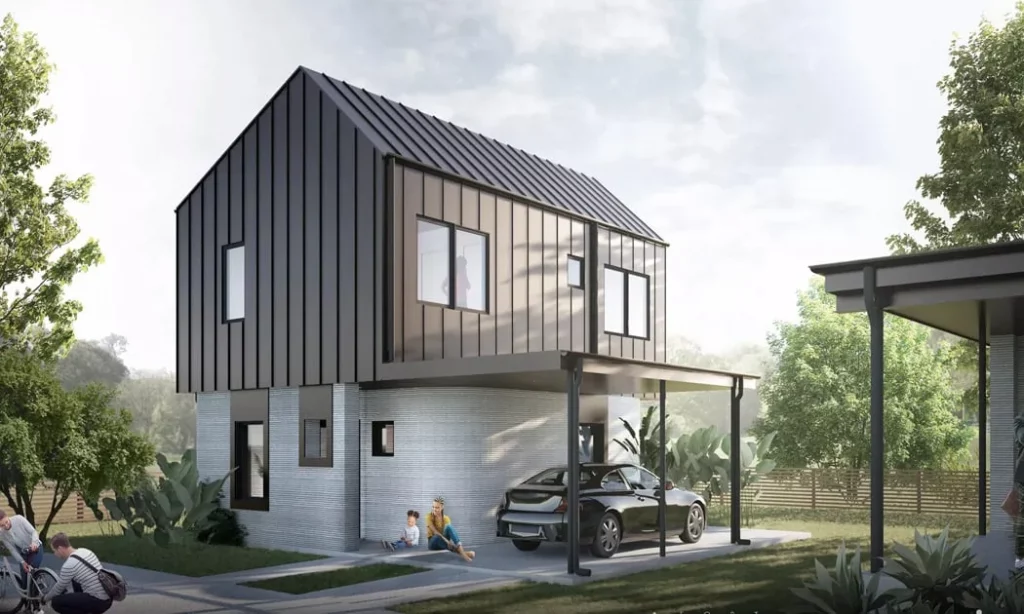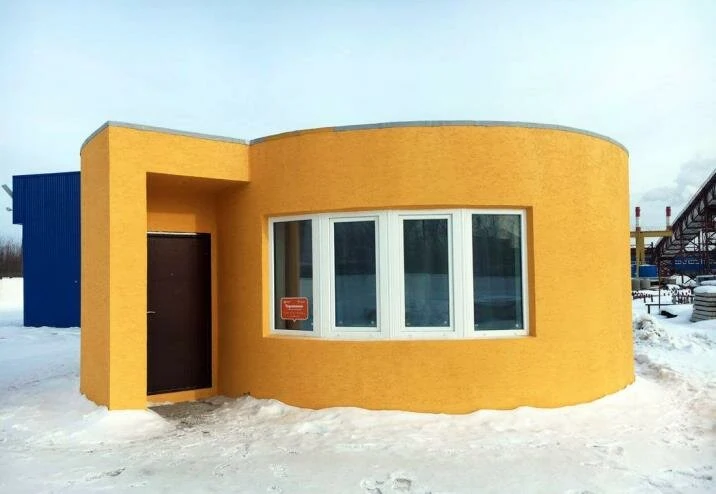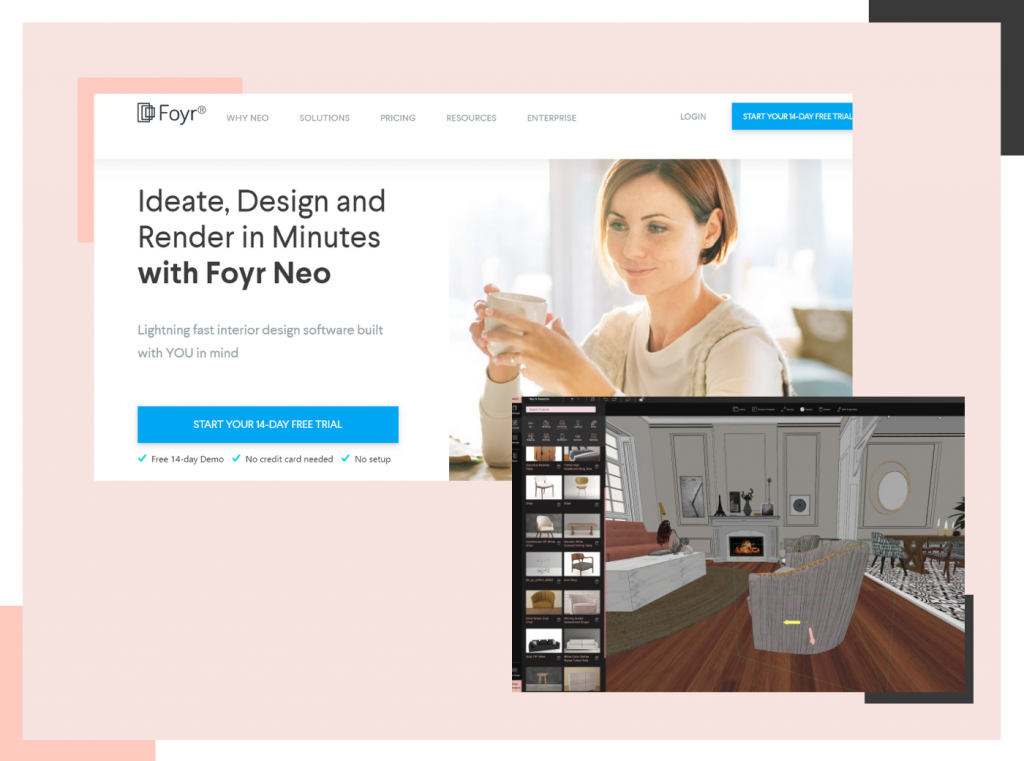Table of Contents
Crafted by sophisticated 3D printers like WASP, these homes offer customization, cost-efficiency, and eco-friendliness, distinct from conventional construction methods. This piece delves into the world of 3D printed homes, showcasing leading global examples, exploring the technology’s capabilities, challenges, and its potential to redefine housing’s future.
So, let’s dive in!
The Rise of 3D printed Houses
Have you ever imagined a two-bedroom or three-bedroom house being constructed in just a matter of hours? With the advent of 3D printing technology, this seemingly far-fetched idea has become a reality. The construction industry is undergoing a revolution, and 3D printed homes are at the forefront of this transformation. A notable example is the living room designed by Kamp C which seamlessly integrates the house’s overall design.
Image credits – yankodesign
So how does it work? Using large-scale 3D printers that can extrude layers upon layers of specialized materials, these innovative machines create entire structures from scratch, some of which span hundreds of square meters. This groundbreaking method offers numerous advantages over traditional construction methods, such as:
Speed:
Speed plays a major role. With conventional methods, constructing a concrete house can take months or even years. However, with the collaboration with organizations like NASA and the world’s first 3D printing technology, a new project milestone has been achieved and homes can be built in just a few days! This accelerated process could potentially address housing shortages and provide quick relief during times of crisis.
Cost:
Cost is another significant factor to consider. Nonprofits like New Story are exploring the possibilities of reducing costs for housing in underserved areas. By eliminating many manual, labor-intensive tasks and reducing material waste, the cost per square foot for 3D printed houses can be significantly lower compared to traditionally-built homes. This affordability opens up new possibilities for affordable housing solutions worldwide.
Sustainability:
Sustainability also takes center stage with 3D printed houses. Solar panels are often integrated into these designs to enhance energy efficiency. These structures have the potential to minimize environmental impact by utilizing eco-friendly materials like recycled plastics or bio-plastic substances as building material for printing. In addition to this sustainable approach, energy-efficient designs can be seamlessly integrated into the construction process by companies like Mighty Buildings..
Amidst all these advancements in technology and methodology lies an array of notable pioneers and companies pushing boundaries in the field of 3D printed housing. Companies such as ICON, Peri, Apis Cor and Winsun have successfully showcased their ability to construct beautiful and affordable homes using cutting-edge techniques throughout the world.
Read also – Traditional Architecture vs Modern Architecture
Architectural Wonders: 3D printed House Examples
In the world of construction, 3D printing has opened up a realm of possibilities for architects and designers. These groundbreaking technologies have given birth to some truly awe-inspiring architectural wonders that push the boundaries of modern architecture.
ICON’s 3D printed house in Austin, Texas: Showcasing innovation and affordability:
Image credits – icon
The Icon 3D printed homes in Austin, Texas showcases both affordability and sustainability. The company utilized a large-scale 3D printer known as the Vulcan II to construct this remarkable startup home in just a few days. With its sleek design and high-quality finish, it proves that 3D printed houses can rival traditional construction methods while offering cost-effective solutions.
Apis Cor’s house in Russia: A testament to rapid construction and design flexibility
Image credits – Apis Cor
Another standout example is Apis Cor’s house in Russia. This structure serves as a testament to rapid construction and design flexibility. By utilizing their unique mobile printer and special concrete mixtures, the leading homebuilding company could construct an entire house on-site within just 24 hours! Not only does this showcase the speed at which these homes can be built, but it also highlights the ability to create intricate designs easily.
Winsun’s impressive structures in China: Addressing housing challenges with technology
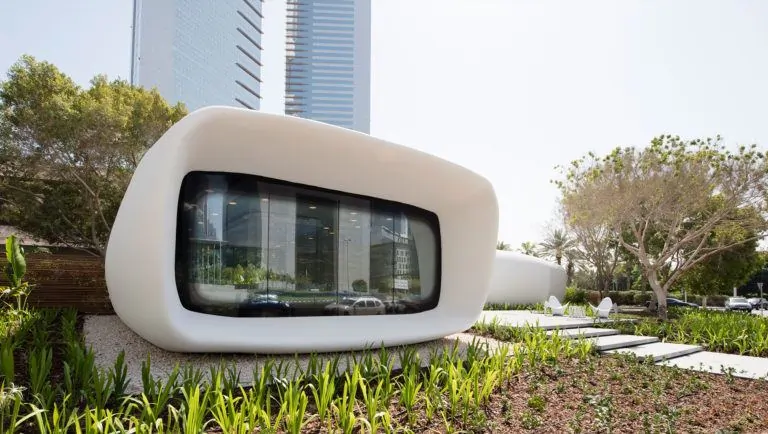
Image credits – Winsun’s website
Winsun, a Chinese real estate company, has also made waves in the field with its impressive structures. Using recycled materials mixed with quick-drying cement, they have successfully printed entire apartment buildings and villas at astonishing speeds. These projects address pressing housing challenges by providing affordable yet durable living spaces.
What sets these examples apart is not only their groundbreaking technology but also the incorporation of intricate architectural details that were once thought impossible through traditional means.
Pushing the Limits: Extraordinary Features of 3D Printed Houses
Architectural enthusiasts and technology experts alike are awe-inspired by the extraordinary features showcased in 3D printed houses. These cutting-edge structures push the boundaries of traditional construction methods, highlighting the infinite possibilities of this innovative technology. Such extraordinary features of 3D printed houses are:
Incorporating intricate architectural details through 3D printing
One remarkable aspect of 3D printed houses is their ability to incorporate intricate architectural details that were previously difficult or costly to achieve. With precise layering and intricate design capabilities, these houses can showcase stunning facades, ornate patterns, and even unique structural elements that defy conventional norms.
Customization and personalization possibilities
Customization and personalization are taken to new heights with 3D printing. Homeowners can now have complete control over every aspect of their living spaces, from room layouts to furniture designs. This level of customization allows for truly personalized homes that reflect individual tastes and preferences like never before.
Integration of sustainable materials and energy-efficient designs
Sustainability has also become a key focus in modern architecture, and 3D printed houses excel in this area as well. By utilizing eco-friendly materials such as recycled plastics or sustainable concrete mixes, these homes minimize environmental impact while still providing excellent structural integrity.
Read also – Green Living: 10 Ways to Turn Your Home from Toxic to Eco-friendly
Challenges and Future Prospects of 3D Printed Housing
Just like any groundbreaking idea, 3D printed houses come with their own set of challenges and future prospects:
Navigating regulatory hurdles and building code compliance
Navigating regulatory hurdles and building code compliance is one of the key challenges facing the adoption of 3D printed housing. As this technology disrupts traditional construction methods, authorities need to establish guidelines to ensure safety standards are met. Addressing concerns related to structural integrity, fire resistance, and durability is crucial for widespread acceptance.
Scaling up for larger structures: Skyscrapers and commercial buildings
Scaling up for larger structures presents another hurdle in the path of 3D printed housing. While we have seen impressive examples of single-story homes being constructed with this technology, there is still work to be done when it comes to high-rise buildings and commercial structures. The engineering complexities associated with tall buildings require further research and development.
However, despite these challenges, the potential for addressing global housing crises through 3D printing is immense. With its ability to construct affordable homes quickly and sustainably, this technology holds promise in tackling issues such as homelessness and inadequate housing around the world.
The Role of 3D Printing in Shaping Future Cities
The role of 3D printing designs in shaping future cities cannot be overstated. From enabling creative architectural designs to providing affordable housing solutions and promoting sustainability practices – this transformative technology holds immense potential for creating smarter, greener, and more livable urban environments for generations to come.
Impact on urban planning and design
One of the key roles that 3D printing can play in shaping future cities is its impact on urban planning and design. With traditional construction methods, there are limitations on architectural designs due to cost and time constraints. However, with 3D printing, architects have greater freedom to create unique and visually stunning structures that were once deemed impractical or unaffordable.
Affordable housing solutions for growing urban populations
As cities face affordability issues, 3D printed houses offer a promising solution. The cost-effectiveness of this technology makes it feasible to construct affordable housing at scale without compromising quality or design. This opens up possibilities for creating vibrant communities where people from all walks of life can thrive.
Creating adaptable and resilient urban environments
3D printing shines in adaptability, allowing buildings to evolve with changing urban needs. Through customization, structures can be effortlessly altered or expanded. Moreover, with sustainability crucial for future constructions, traditional methods often result in waste and high energy use. However, 3D printing combines sustainable materials, like recycled ones, with efficient designs, fostering eco-friendly structures that optimize functionality while reducing environmental impact.
Innovations in 3D Printing Techniques for Construction
The field of 3D printing designs continues to evolve, pushing the boundaries of what is possible in construction. Architects, engineers, and technology experts are constantly exploring new techniques and materials to enhance the capabilities of this revolutionary technology.
One area where significant progress has been made is in advancements in materials used for 3D printing houses. While concrete has traditionally been the go-to material for construction, researchers have been experimenting with alternative options such as recycled materials. By harnessing the power of recycling, reducing waste and creating more sustainable homes is possible.
Another exciting development is the use of robotic automation and AI-assisted construction processes. These technologies allow for precise control over every aspect of the building process, resulting in faster and more efficient construction. Robots can be programmed to perform tasks that were once done by humans, reducing labor costs and increasing productivity.
Collaboration between architects, engineers, and technology experts is also crucial in driving innovation forward. By combining their expertise, these professionals can find new ways to optimize designs, improve structural integrity, and overcome challenges that arise during the 3D printing process.
Conclusion
The advancements in 3D printed houses are just the beginning. This technology unlocks previously unimagined architectural solutions, signaling we’re only starting to tap its full potential.
To dive into this architectural shift, join Foyr Neo, the premier platform for both individuals and professionals to experience architecture’s future. Foyr Neo equips you with tools to actualize your innovative design ideas. So, what are you waiting for? With Foyr Neo, let’s revolutionize our architectural vision and home construction.
Frequently Asked Questions
What exactly is a 3D printed house?
A 3D printed house is a structure that is built using additive manufacturing techniques, layer by layer, using materials such as concrete or plastic. It is created by a large scale 3D printer following a computer-generated design, resulting in a fully functional living space.
Are 3D printed houses cheaper to build?
Yes, 3D printed houses can be cheaper to build compared to traditional construction methods because they require fewer laborers, less time, and lower material costs. Additionally, the automated process reduces human error and waste, further reducing expenses.
How long do 3D printed houses last?
The lifespan of a 3D printed house can vary depending on various factors, such as maintenance and the quality of materials used during construction. However, with proper care, they are estimated to last as long as traditional houses, typically around 50 to 100 years.
Are 3D printed houses cold?
No, 3D printed houses are not inherently cold. The temperature inside a 3D printed house can be regulated through adequate insulation and heating systems, just like in any traditional house.
Are 3D printed houses waterproof?
Yes, 3D printed houses can be made waterproof. Proper construction techniques and materials, such as waterproof coatings, membranes, and sealants, can ensure that the printed houses are resistant to water infiltration.
Are 3D printed houses fireproof?
While the materials used in 3D printed houses can vary, many researchers and companies are developing fire-resistant materials specifically for 3D printing. This suggests that it is possible to create 3D printed houses that are fireproof or have high fire resistance.









